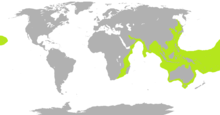| Sea snake Temporal range:
| |
|---|---|

| |
| Yellow-bellied sea snake (Hydrophis platurus) on a Costa Rica beach | |
| Scientific classification | |
| Domain: | Eukaryota |
| Kingdom: | Animalia |
| Phylum: | Chordata |
| Class: | Reptilia |
| Order: | Squamata |
| Suborder: | Serpentes |
| Superfamily: | Elapoidea |
| Family: | Elapidae |
| Groups included | |

| |
| Range of sea snakes shown in lime green, except the widespread, pelagic yellow-bellied sea snake | |
Sea snakes, or coral reef snakes, are elapid snakes that inhabit marine environments for most or all of their lives. They belong to two subfamilies, Hydrophiinae and Laticaudinae. Hydrophiinae also includes Australasian terrestrial snakes, whereas Laticaudinae only includes the sea kraits (Laticauda), of which three species are found exclusively in freshwater. If these three freshwater species are excluded, there are 69 species of sea snakes divided among seven genera.[2]
Most sea snakes are venomous, except the genus Emydocephalus, which feeds almost exclusively on fish eggs.[3] Sea snakes are extensively adapted to a fully aquatic life and are unable to move on land, except for the sea kraits, which have limited land movement. They are found in warm coastal waters from the Indian Ocean to the Pacific and are closely related to venomous terrestrial snakes in Australia.[4]
All sea snakes have paddle-like tails and many have laterally compressed bodies that give them an eel-like appearance. Unlike fish, they do not have gills and must surface regularly to breathe. Along with Cetaceans, they are among the most completely aquatic of all extant air-breathing vertebrates.[5] Among this group are species with some of the most potent venoms of all snakes. Some have gentle dispositions and bite only when provoked, while others are much more aggressive.
- ^ Dudgeon, Christine L.; White, William T. (2012). "First record of potential Batesian mimicry in an elasmobranch: juvenile zebra sharks mimic banded sea snakes?". Marine and Freshwater Research. 63 (6): 545. doi:10.1071/MF11211. ISSN 1323-1650.
- ^ Uetz, P.; Freed, P.; Aguilar, R.; Hošek, J., eds. (2022). "Elapidae". The Reptile Database. Retrieved 9 May 2022.
- ^ Minton, S. A. (1983). "Lethal toxicity of venoms of snakes from the Coral Sea". Toxicon. 21 (6): 901–902. doi:10.1016/0041-0101(83)90082-x. PMID 6658813.
- ^ Hutchings, Pat (2008). The Great Barrier Reef: Biology, Environment and Management. Csiro Publishing. p. 345. ISBN 9780643099975.
Sea snakes are true reptiles closely related to Australian venomous terrestrial snakes. Indeed, both groups are included in a single subfamily, Hydrophiinae, by most modern herpetologists.
- ^ Parker HW, Grandison AGC. 1977. Snakes – a natural history. Second Edition. British Museum (Natural History) and Cornell University Press. 108 pp. 16 plates. LCCCN 76-54625. ISBN 0-8014-1095-9 (cloth), ISBN 0-8014-9164-9 (paper).